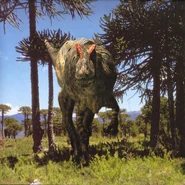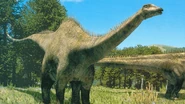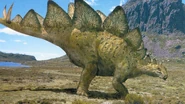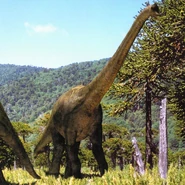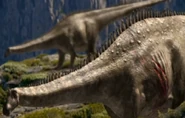| Time of the Titans | ||||||||||||
|---|---|---|---|---|---|---|---|---|---|---|---|---|

| ||||||||||||
| Previous episode The Making of Walking with Dinosaurs |
Following episode Cruel Sea | |||||||||||
Time of the Titans - broadcast in North America as Jurassic Giants - is the second episode of Walking with Dinosaurs.
Summary
This episode follows the diverse Jurassic megafauna in North America. The episode mainly concentrates on the lives of a adolescent female Diplodocus and her constant fight for survival against predators and even her own habitat after hatching. The episode also follows an adult herd of Diplodocus and their ceaseless search for food. This episode showcases some of the other late Jurassic fauna including the armored and dim-witted Stegosaurus, the egg-thieving Ornitholestes, and 'the lions of the Jurassic', Allosaurus.
Full synopsis
The episode begins in the late Jurassic period with a mother Diplodocus laying her eggs into a deep trench. Each individual egg is the size of a football. After laying her eggs, she carefully buries them and leaves them to their fate. She then slowly moved out of the forest she was in to rejoin her herd in the fern plains.
Months later, we return to the hatching site. However, some of the eggs have been discovered by an Ornitholestes - an egg thief. Then, a little female Diplodocus emerges from the soil trying to escape. She is caught within the sight of the Ornitholestes but he is too busy eating to chase more Diplodocus. While her siblings escape, the little female rests but then gets up and joins them. After scurrying deeper in the forest, the sauropodlets find safety, The Diplodocus creche then starts feeding on the tender ferns between the tree trunks of the forest. However, an Ornitholestes appears. The sauropodlets crouch and remain motionless while the predator passes by. Their plan had worked.
It then cuts to the open prairies where we see two Stegosaurus and the massive herd of Diplodocus. When the herd begins to feed, they attract insects and insect hunters like damselflies. They even attract Anurognathus - a genus of pterosaur which feed on insects. The pterosaurs fight, feed and breed on the Diplodocus. When the Diplodocus defecate, they attract dung beetles. The Diplodocus herd then moves on, carrying its own unique habitat with them.
A year later, the Diplodocus creche is seen feeding within a canyon which connects to the prairies. Due to that, a male Stegosaurus appears and starts drinking from a tiny stream. While the herbivores feed, a pair of large Allosaurus stalk the canyon. When the creche catches sight of the predators, they run. However, an Allosaurus managed to kill one of the Diplodocus. The small brained Stegosaurus is startled by the Diplodocus creche and accidentally kills another one of the sauropodlets. The other Allosaurus confronts the Stegosaurus but it is intimidated by the Stegosaurus' frightening display of color. The Allosaurus then backs down and joins the other Allosaurus to feed on the Diplodocus corpse. The remaining Diplodocus return to the forest and begin feeding again. Nearby, the little female finds the skeleton of an adult Diplodocus. The creche then goes deeper into the forest.
It then cuts to the adult herd clearing the edge of the forest. They are doing this so that they can feed on the soft ferns in between them. Whilst they feed, they expel excess gas. The herd then moves on in their remorseless search for food.
Four years later, an Anurognathus is seen looking for a host. It then finds the female Diplodocus along with her siblings who are now 12 meters long. Predators like Ornitholestes are no longer a threat. The creche has moved to the outskirts of the forest as they are getting too large to stay in the deep forest. The Diplodocus creche goes to the river to drink but catch the scent of smoke. It's a large forest fire. The Diplodocus slowly escape the flames. During the night, the fire ignites all of the trees and kills a vast plethora of animals.
The next day, it's revealed that only three Diplodocus managed to survive and are driven out into the open prairies. The creche pass by a resting pair of Allosaurus but the carnivores do not attack them. Then, a large Brachiosaurus encounters the creche and starts feeding on the tree tops. The Diplodocus do not have the same size advantages so they need the protection of an adult herd urgently. Only two youngsters have survived and need help. Then, the massive adult herd of Diplodocus appear. A huge elderly female sizes up the two youngsters and accepts them. They are safe at last. The herd then begins feeding.
Five years later, the herd is at full strength. It is now breeding season and the young female is now old enough and big enough to reproduce. The males have started to display. They do this by rearing up on their hind legs to impress females. Occasionally, the males get physical and fights break out. The victor wins the right to mate. The young female is approached by a young male. She responds by stamps and then responds using very low frequency rumbles. She then shows she is receptive and then the male mounts her.
After a few days, the Diplodocus have calmed. The young female feeds outside the herd but she is being watched by a pair of Allosaurus. She then notices the Allosaurus and turns to get away. The Allosaurus chases the female and then attacks her. She attempts to escape but is pursued by the Allosaurus. She tries to ward off the Allosaurus but in unsuccessful. However, the older female Diplodocus' whip-like tail hits the Allosaurus. She survives and returns to the herd despite the serious wounds on her side. The herd then moves on.
Appearances
Creatures
- Diplodocus
- Anurognathus
- Dryosaurus (unidentified)
- Ornitholestes (first appearance)
- Stegosaurus
- Allosaurus (first appearance)
- Brachiosaurus (first appearance)
- Damselfly (live acted, first appearance)
- Dung beetle (live acted, first appearance)
Locations
Time periods
Trivia
- This episode features the first feathered animal in the series - Ornitholestes.
Gallery
Promotional Images
Errors
- Diplodocus could never reach adulthood in only a decade. The minimum amount of time it would take for Diplodocus to reach adulthood was forty years.
- Ornitholestes never had a nasal crest.
- Anurognathus lived in Germany, not North America. They were microbat-like insectivores, and did not behave like modern oxpeckers do. Its anatomy is also very inconsistent with the real animal, with a typically elongated neck, deep skull and small wings
- Allosaurus's anatomy is inconsistent with the real animal too.
Broadcast
Original airdate
- 11 October 1999 20.30 BBC One
Repeats
- 12 October 1999 18.30 BBC Choice
- 16 October 1999 20.00 BBC Choice
- 17 October 1999 16.45 BBC One
- 17 October 1999 19.30 BBC Choice
- 4 December 1999 7.30 BBC Knowledge
- 5 August 2000 20.05 BBC One
- 15 January 2003 19.00 BBC Four
- 24 February 2004 1.10 BBC One
- 14 October 2006 19.45 BBC Three

